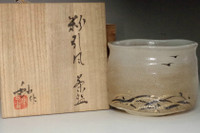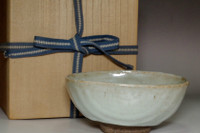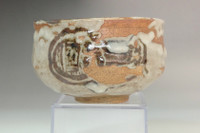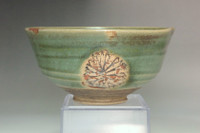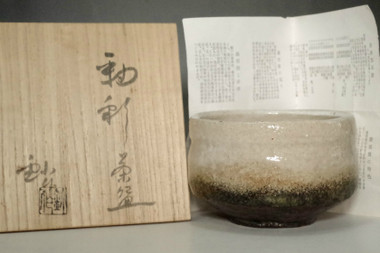 Loading... Please wait...
Loading... Please wait...Currency Displayed in
- Home
- SOLD ITEMS
- Kato Sho (1927-2001) Seto ware tea bowl #3504
Categories
Kato Sho (1927-2001) Seto ware tea bowl #3504 for sale
Product Description
Up for sale is this "Kato Sho (1927-2001) Seto ware tea bowl #3504" If you have any questions please contact us before buy it. No reserve.
- width: approx. 12.3cm (4 27/32in)
- tall: approx. 8.3cm (3 17/64in)
- weight: 379g (gross 624g)
Seto ware
Although legend has it that ceramics in the Seto ware began when its forefather, Kato Shiroemon Kagemasa, built a kiln there in 1242 after having studied the methods from the Song dynasty in China, the origins of pottery-making in the area are much more ancient, dating back to the Tumulus period.
During the Kamakura period the Seto ware was the only one in Japan which produced glazed pottery. The flourishing of trade between Japan and the Song from the Heian to the Kamakura period led to a large volume of ceramics being brought in from the continent; the extant domestic ash glaze could no longer compete, which led to various changes in the Seto ware as well.
By the Muromacho period the tea ceremony had become popular, and once the Seto potters made tea things preferentially. The role of Seto region became a producer of practical tableware.
During the Warring States period many potters fled Seto for Mino in order to escape the war, as the term "Seto-yama-risan (Flight from Seto mountain)" suggests, where they received protection under the policies of Oda Nobunaga. Bowls and decorative plates with the distinctive style of Seto ware, Oribe, Shino and Ki-seto have been discovered in the remains of Mino's kilns from this period.
Upon entering the Edo period, the potters who had left Seto as part of the "Seto-yama-risan" returned to Seto region once again. The Owari branch of the Tokugawa family summoned the potters back to Seto as part of the so-called "Kamadoya-yobimodoshi (Summons to the kilns)", and the Seto area flourished once more.
However, the Seto area entered a difficult period due to their delay, as Kyushu's Arita ware expanded their sales routes from Imari port to Europe and beyond thanks to the temporary halt in exports from China, the biggest producer of ceramics.
In the late Edo period (1807), Kato Tamikichi, who had studied ceramics in Kyushu's Arita area and elsewhere, returned to Seto and regularized ceramic production there, leading to a dramatic change in Seto's pottery scene.
From that point onward, Seto's ceramics adapted well to the styles of the period and expanded production, even frequently exporting overseas during the Meiji period.
Japan the term "Seto-mono (Seto item)" is synonymous with ceramics at the present time.
shop policy
AppraisalWe are a very small team with limited resources and are unable to conduct scientific age verification or appraisals by the artist’s descendants. We evaluate items using specialized reference books, scholarly resources, and knowledge inherited from senior experts in the field. If a purchased item does not meet your expectations, please feel free to contact us. We sincerely value your opinion.
Cancellation and Return
We accept return only if you contact us within 30 days after you receive the items. Return-shipping costs are the buyer’s responsibility. If you ask a cancellation before shipping the package, we may ask a 20% restocking fee.
Shipping
+ Shipping to the USA, Europe, and Asia is free. For other areas, please contact us. Shipping is via EMS or DHL.
+ VAT is not included in the item price.
+ We will ship within 3 business days. Shipping time is usually around a week.
Insurance
We are not responsible for delays, returns, damage or loss due to customs or postal processing. EMS is insured (the amount on the label is the guaranteed amount). If you choose DHL, we recommend that you purchase additional insurance. Please note that if you choose the DHL drop service option, insurance will not be applied.
Taxes
Import duties, taxes and fees are not included in the item price. If your country requires customs duties, etc., it is your responsibility to pay them.
To customers buying tableware
Our products are mostly used. We sell them in the same condition they were purchased, please be sure to clean them thoroughly before actually using them.

